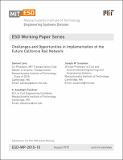| dc.contributor.author | Levy, Samuel | |
| dc.contributor.author | Faulkner, A. Awadagin | |
| dc.contributor.author | Sussman, Joseph M. | |
| dc.date.accessioned | 2016-06-07T00:54:36Z | |
| dc.date.available | 2016-06-07T00:54:36Z | |
| dc.date.issued | 2015-08 | |
| dc.identifier.uri | http://hdl.handle.net/1721.1/103030 | |
| dc.description.abstract | The California High-Speed Rail Authority (CHSRA) adopted a "blended system" at the northern and southern termini of the planned first phase of its high-speed rail line. In this blended operation, the high-speed rail line will share track and other infrastructure with commuter, intercity, and freight rail. However, the lack of common infrastructure among rail modes and the financial and organizational challenges associated with building that common infrastructure and capacity allocation in California present challenges for the implementation of high-speed rail via a blended system in the state. This paper reviews the blended system and discusses the level of cooperation and coordination necessary between host railroads/agencies and the high-speed rail tenant operator. Sharing track comes with challenges for all participating railroad operators and often requires coordination between heterogeneous rail traffic. However, costs can be reduced compared to dedicated track. How blended service is carried out will impact state and local agencies, railroad owners and operators, and customers across the California rail network. | en_US |
| dc.language.iso | en_US | en_US |
| dc.publisher | Massachusetts Institute of Technology. Engineering Systems Division | en_US |
| dc.relation.ispartofseries | ESD Working Papers;ESD-WP-2015-10 | |
| dc.title | Challenges and Opportunities in Implementation of the Future California Rail Network | en_US |
| dc.type | Working Paper | en_US |
